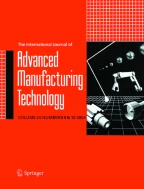Abstract
Numerous design and cost parameters, combined with an endless variety of equipment types, make it difficult to choose the right order picking system (OPS). The purpose of this study is to develop a methodology to support warehouse designers in choosing the most suitable OPS. By developing a new OPS classification, we carried out an in-depth survey on over 68 distribution centres that have been recently built in Italy. The results of the critical analysis allowed developing a design methodology to choose the most suitable OPS. This methodology has been integrated in the structured procedure for OPS design, developed by Yoon and Sharp (IIE Trans 28:379–389, 1996). Finally, a numerical case study is presented to illustrate the application of the proposed design methodology.
Similar content being viewed by others
References
Ashayeri J, Goetschalckx M (1989) Classification and design of order picking. Logistics Inf Manage 2(2):99–106
Drury J (1988) Towards more efficient order picking. IMM Monograph No. 1, The Institute of Materials Management, Cranfield, UK
De Koster R, Le-Duc T, Roodbergen K (2007) Design and control of warehouse order picking: a literature review. Eur J Oper Res 182:481–501
Van der Berg JP (1999) A literature survey on planning and control of warehousing systems. IIE Trans 31:751–762
Goetschalckx M, McGinnis L, Sharp G, Bodner D, Govindaraj T, Huang K (2001) Development of a design methodology for warehousing systems: hierarchical framework. Proceedings of the Industrial Engineering Research, Orlando, FL, USA
Frazelle EH, Hackman ST, Passy U, Platzman LK (1994) The forward reserve problem. In: Ciriani TA, Leachman RC (eds) Optimization in industry 2. Wiley, New York, pp 43–61
Van der Berg JP, Sharp GP, Gademann AJRM (1998) Forward reserve allocation in a warehouse with unit-load replenishment. Eur J Oper Res 111:98–113
Chincholkar AK, Krishnaiah Chetty OV (1996) Simultaneous optimisation of control factors in automated storage and retrieval systems and FMS using stochastic Petri nets and the Taguchi method. Int J Adv Manuf Technol 12(2):137–144
Sankar SS, Ponnanbalam SG, Rajendran C (2003) A multi-objective genetic algorithm for scheduling a flexible manufacturing system. Int J Adv Manuf Technol 22(3–4):229–236
Caron F, Marchet G, Perego A (1998) Routing policies and COI-based storage policies in picker-to-part systems. Int J Prod Res 36:713–732
Caron F, Marchet G, Perego A (2000) Optimal layout in low-level picker-to-part systems. Int J Prod Res 38:101–117
Petersen CG (1997) An evaluation of order picking routing policies. Int J Oper Prod Manage 17(1):1096–1111
Yoon CS, Sharp GP (1995) Example application of the cognitive design procedure for an order pick system: case study. Eur J Oper Res 87:223–246
Yoon CS, Sharp GP (1996) A structured procedure for analysis and design of order pick systems. IIE Trans 28:379–389
Sharp GP (1992) Order picking: principles, practices and advanced analysis, perspectives on material handling practice. www.mhia.org
Hwang H, Oh YH (2004) An evaluation of routing policies for order-picking operations in low-level picker-to-part system. Int J Prod Res 34(18):3873–3889
Dallari F, Marchet G, Ruggeri R (2000) Optimisation of man-on-board automated storage/retrieval systems. Integrated Manuf Syst 11(2):87–93
De Koster R, Le-Duc T (2005) Determining number of zones in a pick-and-pack Order picking System. ERIM Report Series Research in Management
Russel ML, Meller RD (2003) Cost and throughput modeling of manual and automated order fulfillment systems. IIE Trans 35(7):589–603
Frazelle EH (1996), World-class warehousing. Logistics Resources International
Manzini R, Gamberi M, Regattieri A (2005) Design and control of an AS/RS. Int J Adv Manuf Technol 28(7–8):766–774
Frazelle EH (2003) Warehouse benchmarking survey. TLI/WERC
De Koster R, Warffemius PMJ (2005) American, Asia and third-party international warehouse operations in Europe. Int J Oper Prod Manage 25(8):762–780
Montgomery DC, Ranger GC, Hubele NF (2004) Engineering Statistics. John Wiley & Sons
Greene WH (2003) Econometric analysis. Prentice Hall, Upper Saddle, NJ
Hackman ST, Rosenblatt MJ, Olin JM (1990) Allocating items to an automated storage retrieval system. IIE Trans 22(1):7–14
Manzini R, Gamberi M, Persona A, Regattieri A (2006) Design of a class based storage picker to product order picking system. Int J Adv Manuf Technol 32(7–8):811–821
Author information
Authors and Affiliations
Corresponding author
Rights and permissions
About this article
Cite this article
Dallari, F., Marchet, G. & Melacini, M. Design of order picking system. Int J Adv Manuf Technol 42, 1–12 (2009). https://doi.org/10.1007/s00170-008-1571-9
Received:
Accepted:
Published:
Issue Date:
DOI: https://doi.org/10.1007/s00170-008-1571-9
